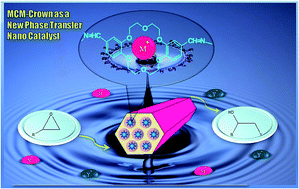MCM-41 bound dibenzo-18-crown-6 ether: a recoverable phase-transfer nano catalyst for smooth and regioselective conversion of oxiranes to β-azidohydrins and β-cyanohydrins in water†
Abstract
A new organic–inorganic hybrid nanocomposite was prepared by immobilizing dibenzo-18-crown-6 onto covalently linked amine functionalized mesoporous MCM-41 via a simple post-synthesis method. The heterogeneous hybrid nanocomposite was characterized by TEM, TGA, BET and FT-IR. The potential applications of this covalently linked crown ether functionalized MCM-41 catalyst were also investigated as an efficient, heterogeneous and recyclable host material for the regioselective ring opening of epoxides by cyanide and azide anions in water. As expected, the cavity of immobilized dibenzo-18-crown-6 demonstrated excellent selectivity of metal ion adsorption and showed better complexation with K+ than Na+ and so the reaction time for the ring opening of epoxides by KCN reduced. Low catalyst loading, high efficiency and reusability are among the advantages of this environmentally friendly method.


 Please wait while we load your content...
Please wait while we load your content...